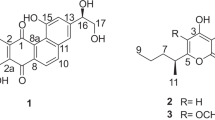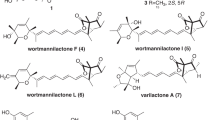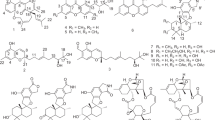Abstract
Assisted by OSMAC strategy, one new p-terphenyl and two new α‑pyrone derivates, namely nocarterphenyl I (1) and nocardiopyrone D–E (2–3), were obtained and characterized from the marine sediment-derived actinomycete Nocardiopsis sp. HDN154086. The structures of these compounds were determined on the basis of MS, NMR spectroscopic data and single-crystal X-ray diffraction. Compound 1 with a rare 2,2’-bithiazole structure among natural products showed promising activity against five bacteria with MIC values ranging from 0.8 to 1.6 μM and 3 exhibited notable antibacterial activity against MRSA compared the positive control ciprofloxacin.
This is a preview of subscription content, access via your institution
Access options
Subscribe to this journal
Receive 12 print issues and online access
$259.00 per year
only $21.58 per issue
Buy this article
- Purchase on Springer Link
- Instant access to full article PDF
Prices may be subject to local taxes which are calculated during checkout



Similar content being viewed by others
Code availability
CCDC 2120740 (for 1) contain the supplementary crystallographic data for this paper. These data can be obtained free of charge via www.ccdc.cam.ac.uk/data_request/cif, or by emailing data_request@ccdc.cam.ac.uk, or by contacting The Cambridge Crystallographic Data Centre, 12 Union Road, Cambridge CB21EZ, UK; fax: +44 1223 336033.
References
Harbarth S, Samore MH. Antimicrobial resistance determinants and future control. Emerg Infect Dis 2005;11:794.
Taiwo SS. Antibiotic-resistant bugs in the 21st century: a public health challenge. Clin Infect Dis. 2011;1:11–16.
Darrow JJ, Avorn J, Kesselheim AS. FDA approval and regulation of pharmaceuticals, 1983-2018. J Am Med Dir Assoc. 2020;323:164–76.
Andrei S, Valeanu L, Chirvasuta R. New FDA approved antibacterial drugs: 2015-2017. Discoveries. 2018;6:2359–32.
De Castro FR, Naranjo OR, Marco JA. New antimicrobial molecules and new antibiotic strategies. Semin. Resp Crit Care. 2009;30:161–71.
Coates ARM, Halls G, Hu Y. Novel classes of antibiotics or more of the same. Br J Pharm. 2011;163:184–94.
Petchiappan A, Chatterji D. Antibiotic resistance: current perspectives. ACS Omega. 2017;2:7400–9.
French GL. The continuing crisis in antibiotic resistance. Int J Antimicrob Agents. 2010;36:3–7.
Li W, Leet JE, Ax HA. Nocathiacins, new thiazolyl peptide antibiotics from Nocardia sp. I. Taxonomy, fermentation and biological activities. J Antibiot. 2003;56:226–31.
Hara S, Ishikawa N, Hara Y, Nabscessins A. and B, aminocyclitol derivatives from Nocardia abscessus IFM 10029T. J Nat Prod. 2017;80:565–8.
Crowley BM, Mori Y, McComas CC. Total synthesis of the ristocetin aglycon. J Am Chem Soc. 2004;126:4310–7.
Chang Y, Che Q, Xing L. Antibacterial p-terphenyl with a rare 2, 2′-bithiazole substructure and related compounds isolated from the marine-derived Actinomycete Nocardiopsis sp. HDN154086. J Nat Prod. 2021;84:1226–31.
Tian Y, Chen Z, Ma M. Nocardiopyrone C, a new antimicrobial pyran-2-one derivative from a marine-derived actinomycete strain Nocardiopsis aegyptia ZSN1. Rec Nat Prod. 2023;17:952–7.
Andrews JM. Determination of minimum inhibitory concentrations. J Antimicrob Chemoth. 2001;48:5–16.
Funding
This work was supported by the National Key Research and Development Program of China (2022YFC2804400), the Fundamental Research Funds for the Central Universities (202172002), the Shandong Provincial Natural Science Foundation (ZR2021MH257), the National Natural Science Foundation of China (41976105), and the NSFC-Shandong Joint Fund (U1906212).
Author information
Authors and Affiliations
Corresponding authors
Ethics declarations
Conflict of interest
The authors declare no competing interests.
Additional information
Publisher’s note Springer Nature remains neutral with regard to jurisdictional claims in published maps and institutional affiliations.
Supplementary information
41429_2023_698_MOESM1_ESM.doc
Antibacterial p-Terphenyl and α‑Pyrone Derivates Isolated from the Marine-Derived Actinomycete Nocardiopsis sp. HDN154086
Rights and permissions
Springer Nature or its licensor (e.g. a society or other partner) holds exclusive rights to this article under a publishing agreement with the author(s) or other rightsholder(s); author self-archiving of the accepted manuscript version of this article is solely governed by the terms of such publishing agreement and applicable law.
About this article
Cite this article
Zhou, L., Chang, Y., Yang, S. et al. Antibacterial p-terphenyl and α‑pyrone derivates isolated from the marine-derived actinomycete Nocardiopsis sp. HDN154086. J Antibiot 77, 201–205 (2024). https://doi.org/10.1038/s41429-023-00698-9
Received:
Revised:
Accepted:
Published:
Issue Date:
DOI: https://doi.org/10.1038/s41429-023-00698-9



